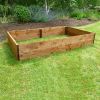Cart is empty
How to Grow Carrots
Index
- Sowing Instructions (Indoors)
- How to Transplant
- Sowing Instructions (Outdoors)
- Crop Maintenance
- How to Harvest
- Pests & Diseases
Sowing Instructions (Indoors)
- Sowing time: Sow from March to September
- Stagger sowing times for a continual harvest
- Sowing Location: When sowing indoors, sow in fibre pots
- Sow 3 to 5 seeds per fibre pot, thin out later
- Prepare fibre pots filling with compost
- Soak soil first, sow seed 1-2cm deep & cover lightly with soil
How to Transplant
- If growing indoors you should transplant out once weather is suitably warm
- Take care not to disturb plant's roots
- Plant fibre pot directly into prepared soil
- Space 7 to 15cm apart depending on variety
- Water well
Sowing Instructions (Outdoors)
- Sowing time: Mid to Late spring & throughout summer
- Sowing location: Direct into rows
- Sow seed 1-2cm deep
- Sow 3 to 4 seeds every 7 to 10cm, thin later
- If thinning is required, do so once seedlings develop their first true leaves
- This minimizes competition & allows for faster growth
- Dispose of thining, do not leave on vegetable plot
- Soil: Prepare soil creating a deep, light & free draining soil
- Heavy clay soils are not suitable – improve by added sufficient well rotted farmyard manure or horticultural grit
- Start digging over soil in late winter or early spring
- Aim to achieve a fine crumbly texture
- When cultivating, remove all weeds, roots, rocks and small stones
- Fresh manure and small stones can cause carrot roots to split
- Do not add manure as it can make the soil too rich for the seeds
- Sand will add drainage so mix seeds with a handful
Crop Maintenance
- Cover early sown seeds & seedlings using garden cloche
- Carrot seeds hate drying out, if sowing in summer make sure to keep moist
- Weed rows regularly
- Protect against carrot fly (See below)
Harvesting
- Pull up carrots as soon as they are big enough to eat
- Best to harvest in the evening to avoid carrot fly attack
- Use a fork to lift, being careful not to damage the carrots
Storage
- Late sown carrots must be lifted by October and stored over winter
- Only store the best undamaged roots
- Cut off foliage, and lay the roots between layers of sand in a storage box
- Store somewhere cool and dry
- Remove any rotten roots
Pests & Diseases
- Pests: Carrot fly
- Damage to carrot: The carrot fly lays eggs that attack the carrot
- Effect on carrot: Larvae leave small black tunnels throughout the root causing wilting
- Carrot fly is a low flying insect
- Reduce attack by: Erecting windbreakers or fine mesh to protect crop
- Remove all thinings from your vegetable plot
- Try growing your carrots on raised beds
- Or try carrot fly resistant varieties such as 'fly away'
- Other plants such as garlic, chives, sage and rosemary will also help to deter carrot fly
- Other pests, diseases & issues include carrot willow aphid, swift moth, green top, forked roots and splitting








